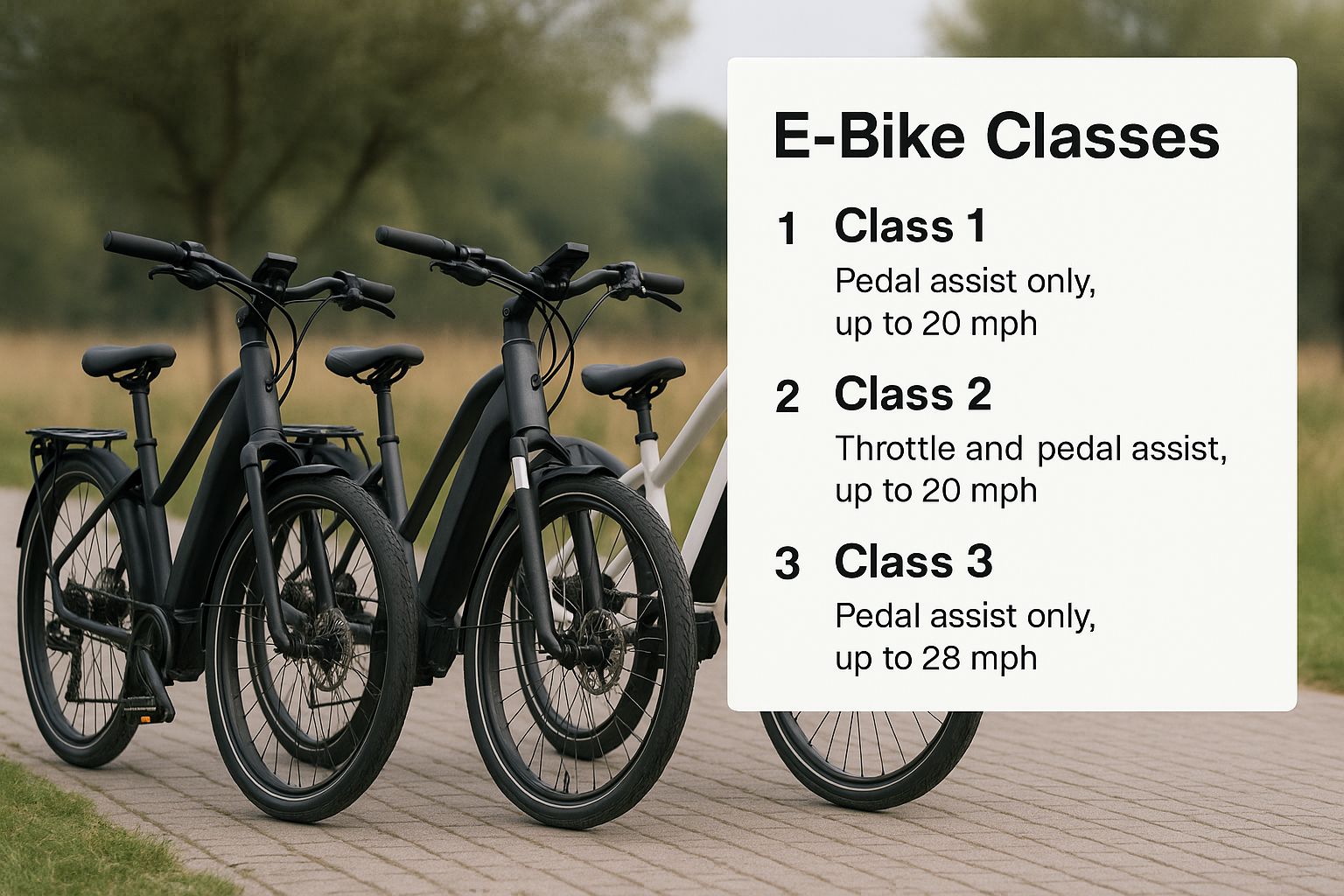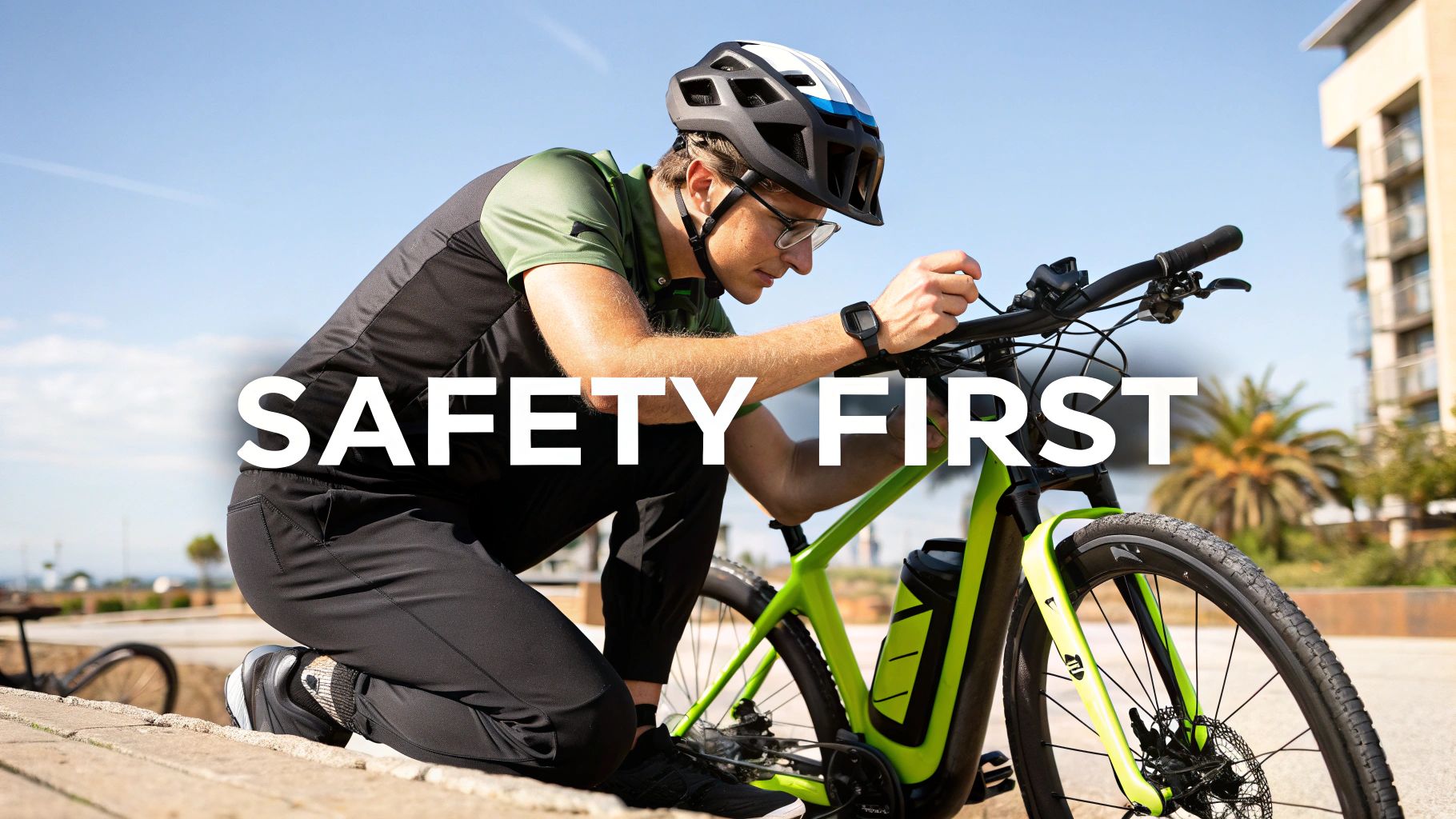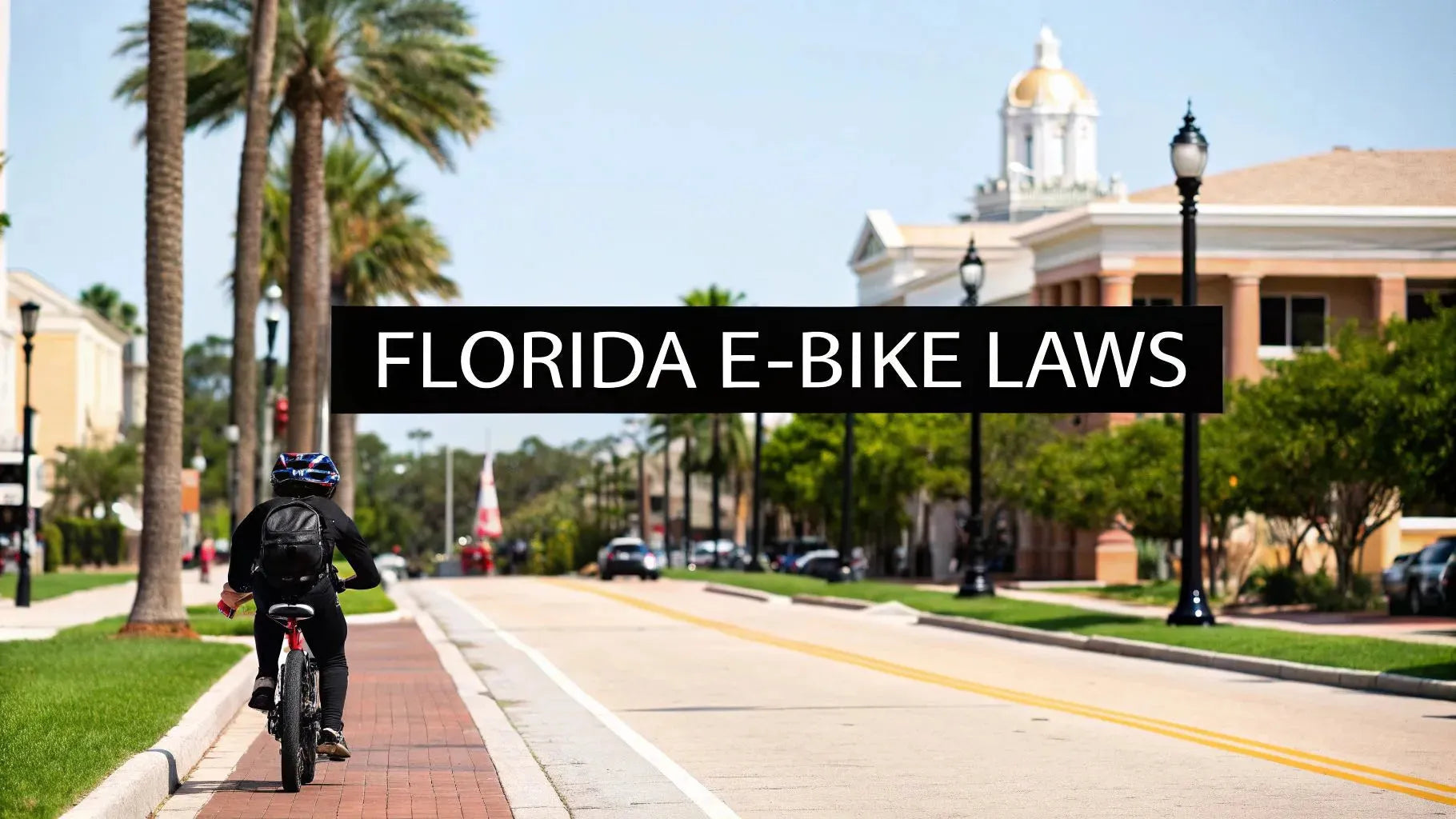Riding an e-bike in the Sunshine State is one of the best ways to get around, but you've got to know the rules of the road. The good news? Florida makes it pretty easy. For the most part, e-bikes are treated just like regular bicycles, which means you don't need a driver's license, registration, or insurance to get going. This simple approach makes hitting the streets or trails a breeze for just about everyone.
Your Guide to Florida E-Bike Rules
Welcome to Florida! With our sunny weather and miles of scenic paths, it's no wonder electric bikes are popping up everywhere. Before you head out, though, it’s smart to get a handle on the local laws to make sure your ride is safe, legal, and stress-free. This guide will cut through the legal jargon and give you the straight scoop on electric bike laws in Florida.
Think of this as your quick-start manual. I'll get right to the point on the big questions, like whether you can ride on the street and what gear you actually need. The whole idea is to give you the confidence to start riding without having to second-guess the rules.
Understanding the Basics
Here’s the most important thing to wrap your head around: Florida law sees your e-bike as a bicycle, not a moped or a motorcycle. This is a huge deal because it means you get all the same rights—and responsibilities—as any other cyclist. This one classification is the foundation for everything else, from where you can ride to whether you need a helmet.
Let's break down what this means for you in practical terms:
- No License Required: You can hop on and ride without a driver's license. It’s that simple.
- No Registration or Insurance: Forget about trips to the DMV or insurance paperwork. Your e-bike is exempt.
- Minimum Age: Anyone can ride a Class 1 or Class 2 e-bike. However, you have to be at least 16 years old to operate a faster Class 3 model.
- Where You Can Ride: Generally speaking, if a regular bike can go there, so can your e-bike. This includes bike lanes, streets, and most multi-use paths.
This straightforward framework was put in place to encourage more people to get out on e-bikes while keeping everyone safe. Just remember, local cities and counties can set their own, sometimes stricter, rules for specific trails or parks, so it never hurts to check local signage.
The core takeaway is simple: Florida treats your e-bike like a standard bicycle, not a motor vehicle. This is the guiding principle behind nearly all statewide regulations and is designed to make e-biking accessible and convenient for everyone.
To give you a quick cheat sheet, I've put together a simple table with the most important rules. It’s a great way to get the key info at a glance.
Florida E-Bike Laws at a Glance
This table is your quick reference for the essential regulations you need to know before you ride.
| Regulation Area | Requirement in Florida |
|---|---|
| E-Bike Classification | Uses the 3-Class System (Class 1, 2, and 3) |
| License Requirement | Not required for any e-bike class |
| Registration/Insurance | Not required |
| Minimum Age (Class 3) | 16 years old |
| Where to Ride | Bike lanes, streets, and trails (unless locally restricted) |
Keep these key points in mind, and you'll be all set for a fantastic and legal ride anywhere in the state.
Understanding the Three E-Bike Classes
When you start digging into Florida's electric bike laws, the first thing you'll notice is that not all e-bikes are treated the same. The state uses a simple three-class system to categorize them based on how the motor works and how fast it can go. It’s basically a label that tells everyone—from you to law enforcement—exactly what kind of bike you're on.
Figuring out which class your e-bike belongs to is the most crucial step to riding legally and safely in the Sunshine State. This single detail determines where you can ride, if you need to be a certain age, and what other rules apply. It’s the foundation for everything else.
Class 1 E-Bikes: Pedal-Assist Power
First up is Class 1, which is probably the most common type you'll see out there. These e-bikes are designed to feel a lot like a regular bicycle, but with a helpful boost. The motor only kicks in to help you while you're actively pedaling. Stop pedaling, and the motor stops, too.
The motor on a Class 1 e-bike will also cut off once you hit 20 mph. This makes them perfect for riders who want a little push on hills or long rides but still want to get some exercise. If you want to get into the nitty-gritty, we have a complete guide that explains what a Class 1 e-bike is in more detail.
This handy infographic breaks down the main differences between the classes at a glance.

As you can see, it all comes down to how the motor is activated and the maximum assisted speed.
Class 2 E-Bikes: Throttle on Demand
Next, we have Class 2 e-bikes. These add a feature that a lot of riders absolutely love: a throttle. This means you can get the motor to push the bike forward even when you aren't pedaling at all. Just twist a grip or push a lever, and you're off.
Just like Class 1, the motor on a Class 2 bike is also capped at 20 mph. This "throttle-on-demand" feature makes them super versatile. You can pedal when you want a workout or just cruise using the throttle when you need a break or want a quick start at a stoplight.
The big deal with Class 2 is the throttle. Even though it can also do pedal-assist like a Class 1, the ability to move without pedaling puts it in a whole different legal category.
This is a key distinction because some local parks or trails might not allow throttle-powered vehicles, so it's always something to check.
Class 3 E-Bikes: The Speedier Commuter
Finally, there's Class 3, the fastest of the bunch. These are also pedal-assist only, just like Class 1, so the motor only works when you're pedaling. The difference? They’re built to go faster, making them ideal for keeping up with city traffic.
A Class 3 motor keeps assisting you all the way up to 28 mph. Because of that extra speed, Florida has a specific age requirement.
You have to be at least 16 years old to ride a Class 3 e-bike. This rule helps ensure riders have the maturity and road awareness to handle the higher speeds safely. These bikes are a favorite for commuters who want to slash their travel time.
To make these differences crystal clear, here’s a simple table breaking it all down.
Comparing Florida's E-Bike Classifications
| Feature | Class 1 E-Bike | Class 2 E-Bike | Class 3 E-Bike |
|---|---|---|---|
| Max Assisted Speed | 20 mph | 20 mph | 28 mph |
| Motor Activation | Pedal-assist only | Throttle and pedal-assist | Pedal-assist only |
| Minimum Rider Age | No state minimum | No state minimum | 16 years old |
Ultimately, understanding these three classes is the key that unlocks all the other electric bike laws in Florida. Once you know if you're on a Class 1, 2, or 3, you'll know exactly which rules of the road apply to you.
Alright, you've figured out your e-bike's class. Now for the million-dollar question: where can you actually ride this thing?
The good news is, Florida keeps it pretty simple for the most part. The state generally treats an electric bike the same way it treats a regular, old-school bicycle. That means you're welcome on most streets, bike lanes, and pathways where you'd pedal a normal bike.
This is huge. It opens up a ton of possibilities, whether you're commuting through city traffic, cruising in a dedicated bike lane, or just enjoying a scenic trail on the weekend. The whole point of the law was to make it easy for people to adopt e-bikes by letting them use the bike infrastructure we already have.

But hold on—it’s not a total free-for-all. While the statewide rule is your starting point, there are some key exceptions to know, especially when it comes to sidewalks and local trails.
Navigating Sidewalks and Bike Paths
This is where things can get a little tricky. While Florida law doesn’t issue a blanket ban on riding e-bikes on sidewalks, it punts that decision to local governments. Your city or county gets the final say.
What does that mean for you? You could be cruising along a sidewalk in a quiet neighborhood without an issue, then cross into a busy downtown district a few miles away and suddenly be breaking the law. Many towns prohibit bikes on sidewalks in commercial areas to keep them clear for pedestrians.
The golden rule for sidewalks? Pedestrians always win. If you're on a sidewalk where it's allowed, you need to ride slowly, be ready to stop on a dime, and always give people on foot the right of way. No exceptions.
Bike paths and multi-use trails are usually more welcoming. Class 1 and Class 2 e-bikes are typically allowed wherever traditional bikes can go. It’s the faster Class 3 e-bikes, which can hit 28 mph, that sometimes face restrictions on certain trails to avoid conflicts with walkers, joggers, and slower cyclists.
Here are a few things to keep in mind on any path:
- Look for signs. Local parks and trails are required to post signs if e-bikes are restricted. Always check the trailhead for the rules.
- Obey the speed limit. If a trail has a posted speed limit, it applies to you, too.
- Give a heads-up! A simple "on your left!" or a quick ring of your bell before you pass someone is just common courtesy and makes the trail safer for everyone.
The laws are always evolving as more people discover how awesome e-bikes are. For a bigger-picture view, check out our guide on whether electric bikes are street legal in different places.
The Power of Local Control
If there's one concept you need to burn into your brain, it's local control. The state sets the general framework, but it gives cities, counties, and park districts the power to make their own rules.
Think of it this way: Florida built the main highway, but each town can set its own speed limits and traffic rules on its local streets. One beach town might welcome e-bikes on its boardwalk with open arms, while the very next town over might ban them completely.
This patchwork of rules means you have to be a little proactive. For example, a 2020 Florida law cemented the right for local governments to create their own e-bike rules. A prime example is Fort Myers Beach, which banned e-bikes on its streets back on May 4, 2018. It just goes to show how different the rules can be from one place to another.
So, how do you stay out of trouble? It’s pretty simple:
- Check the City's Website: Before heading to a new spot, a quick Google search for the city’s name plus "e-bike ordinance" usually does the trick.
- Call the Parks Department: Planning a trail ride? The fastest way to get a straight answer is to just call the local parks and rec department.
- Read the Signs: When in doubt, trust the signs. Trailheads and park entrances almost always spell out the dos and don'ts.
By getting familiar with the idea of local control and doing a quick check before you ride, you can make sure your trip is fun, safe, and—most importantly—legal, no matter where you're exploring in the Sunshine State.
Helmets and Other Rules of the Road

Alright, you've figured out your e-bike class and where you're allowed to ride. Now, let's get into the other key rules you need to know: helmets, licenses, registration, and insurance. The good news? Florida keeps things refreshingly simple.
Because electric bike laws in Florida treat e-bikes like regular bicycles (not motor vehicles), you get to skip a ton of the usual bureaucratic headaches. This means you do not need a driver's license, registration, or any special insurance to ride a Class 1, 2, or 3 e-bike. That simple fact makes hopping on an e-bike both easy and affordable.
Understanding Florida's Helmet Rules
While you can forget about licenses and registration, helmets are a different story. Florida has a very clear, statewide rule that's easy to remember, especially when it comes to younger riders.
For anyone under the age of 16, wearing a properly fitted bicycle helmet is an absolute must. No exceptions. It doesn't matter what class of e-bike they're on. This law is all about protecting the state’s youngest and most vulnerable cyclists.
For riders who are 16 years old and over, things change a bit. You aren't legally required to wear a helmet on a Class 1 or Class 2 e-bike. But the moment you jump on a faster Class 3 e-bike—which can hit speeds up to 28 mph—a helmet becomes mandatory for everyone, regardless of age.
To put it simply: Under 16? You need a helmet. 16 or older? A helmet is only required by law if you're on a Class 3 e-bike. It's a straightforward rule based on age and speed.
This tiered system gives riders more freedom on lower-speed models while adding a sensible layer of protection for the zippier e-bikes that can mix it up in city traffic.
Why You Should Always Wear a Helmet Anyway
Even when the law gives you a pass, wearing a helmet is just the smart thing to do. E-bikes are heavier and a whole lot faster than traditional bikes, and unfortunately, e-bike related accidents are on the rise. The most common injuries in these accidents? Traumatic brain injuries. That alone should tell you how critical head protection really is.
Think of it like this: you wouldn't drive a car without a seatbelt, right? A helmet is your head's seatbelt. It is your single most important piece of safety gear. Frighteningly, reports show that only 44% of e-bike riders in accidents were wearing a helmet, a statistic that shows just how many people are taking unnecessary risks.
Must-Have Gear Beyond the Helmet
Being safe is about more than just a helmet. To be truly prepared, especially if you plan on riding at night or in low-light conditions, Florida law mandates a few other pieces of equipment. These rules apply to all bikes, e-bikes included.
Here’s what you absolutely need for riding after dark:
- Front Light: A white light on the front of your bike that can be seen from at least 500 feet away.
- Rear Reflector & Light: On the back, you need a red reflector and a red light, both visible from 600 feet away.
This lighting isn't just about helping you see the road—it’s about making sure drivers and other cyclists can see you. Getting your ride set up with the best electric bike accessories, like good lights, a bell, and mirrors, can make a huge difference in your safety and confidence. It's a small investment for some serious peace of mind.
The Story Behind Florida's E-Bike Legislation
Ever wonder how the current electric bike laws in Florida came to be? They didn't just pop up overnight. The rules we have today are the result of a deliberate effort to catch up with technology and bring some much-needed order to our roads and trails.
Before 2020, Florida was pretty much the Wild West for e-bikes. These fantastic machines were stuck in a legal gray area, often getting incorrectly lumped in with mopeds or scooters. This created a huge mess for everyone—riders had no idea what was legal, and law enforcement didn't have clear guidelines to follow.
This ambiguity meant that, technically, e-bike riders could be told they needed a driver's license, registration, and even insurance, just like someone on a moped. It was a clunky, outdated system that really held people back from jumping on this fun, eco-friendly way to get around. The state desperately needed a modern fix.
A New Chapter in 2020
The big shift happened in 2020 when Florida lawmakers finally passed a new statute that officially defined what an electric bike is and set clear rules for it. This law was a total game-changer, pulling e-bikes out of that confusing legal limbo once and for all.
The most important part of this new law was adopting the three-class system. By creating clear definitions for Class 1, Class 2, and Class 3 e-bikes, the state established a simple, effective framework that riders, manufacturers, and bike shops could easily understand. It finally answered all the big questions.
The core idea was simple but powerful: treat e-bikes more like traditional bicycles, not motor vehicles. That single decision wiped out the need for a license, registration, and insurance, opening the door for thousands of Floridians to start e-biking with confidence.
Following a National Trend
Florida didn't come up with this idea in a vacuum. It was part of a much larger, nationwide movement to create consistent e-bike laws. For years, states all over the country had been trying to figure out how to handle this new wave of transportation.
The groundwork was laid years earlier. A federal law back in 2002 set a baseline for what a "low-speed electric bicycle" was, but it didn't require states to adopt that standard. As a result, by the time Florida passed its law in 2020, more than 30 other states had already taken the lead in separating e-bikes from mopeds. If you're curious, you can learn more about the earliest days of electric bike laws in the USA to see how it all unfolded.
By adopting the three-class model, Florida aligned itself with a proven, industry-backed standard that was already working well elsewhere. This brought a ton of benefits:
- Consistency for Riders: Travelers and snowbirds could finally ride in Florida without having to guess the rules.
- Clarity for Manufacturers: Bike companies could sell their products here without worrying about confusing, state-specific regulations.
- Simplicity for Law Enforcement: Police now had a clear, easy-to-understand system for keeping the roads safe.
Understanding this history is key. Florida's modern e-bike laws are a direct response to past confusion, reflecting a commonsense approach that balances safety, accessibility, and technological progress.
This whole legislative journey shows a smart effort to adapt to the times. By looking at what worked in other states and listening to what riders and the industry needed, Florida created rules that just make sense. It’s a story of moving from a legal gray area to a clear, sunny path forward for all of us e-bike lovers in the Sunshine State.
Common Questions About Florida E-Bike Laws
Even after going through the rules, it's totally normal to have a few "what if" scenarios bouncing around in your head. Let's clear up some of the most common questions we get from riders all the time.
Think of this as your quick-and-dirty FAQ for riding in the Sunshine State. We'll get straight to the point on the stuff that really matters.
Do I Need a Driver's License for an E-Bike in Florida?
This is the big one, and the answer is fantastic news: No, you do not need a driver's license.
Florida law keeps things simple. It looks at a properly classified e-bike (Class 1, 2, or 3) and calls it what it is: a bicycle. It’s not a motor vehicle. That single distinction makes all the difference, freeing you from the same rules that apply to cars, mopeds, or motorcycles.
So, you can relax. You don't need to worry about:
- Having a valid driver's license
- Registering your e-bike with the DMV
- Getting license plates
- Carrying special vehicle insurance
This is a huge part of what makes e-bikes so appealing here. They're accessible, stripping away the red tape and making it easy for almost anyone to get out and ride.
Can I Ride My E-Bike on the Sidewalk?
Okay, this is where things get a bit tricky. The short answer is: it depends entirely on the town or city you're in. There isn't a blanket statewide law that says "no e-bikes on sidewalks." Instead, Florida lets local governments call the shots.
This means the rules can literally change from one city limit to the next. In a bustling downtown or a crowded beach town, you'll almost certainly find that riding any bicycle on the sidewalk is a no-go for pedestrian safety. But in a quiet, suburban neighborhood? It might be totally fine.
Your best bet is to play it by ear and look for signs. If you see a "No Bicycles on Sidewalk" sign, that includes your e-bike. When in doubt, the safest place to be is in a bike lane or on the road.
And if you are on a sidewalk where it's allowed, remember the golden rule: pedestrians always, always have the right of way. You need to ride slowly, be ready to stop in a heartbeat, and give people a friendly heads-up with a bell before you pass.
What if My E-Bike Is More Powerful Than 750w?
This is a really important one, because getting it wrong can cause some serious headaches. Florida law is crystal clear on what makes an e-bike an e-bike: its motor has to be 750 watts or less.
If your bike's motor packs more punch than 750 watts, or if it keeps helping you past 28 mph (the limit for a Class 3), it's no longer considered an electric bicycle in the eyes of the law.
So what is it then? It gets bumped up into a different category, most likely a moped or even a motorcycle. That reclassification is a game-changer, and not in a good way. Suddenly, you're on the hook for a whole new set of rules:
- Needing a driver's license with the right endorsement.
- Registering the vehicle with the state and getting a plate.
- Carrying mandatory insurance.
- Wearing a DOT-approved helmet, no matter how old you are.
It’s crucial to make sure the e-bike you buy and ride stays within Florida’s legal definition. Sticking to a Class 1, 2, or 3 is the only way to enjoy the awesome freedom that comes with them. Once you cross that 750w line, you're not riding a bicycle anymore—you're operating a motor vehicle.
Ready to find the perfect ride that's fully compliant with Florida's laws? At Punk Ride LLC, we offer a huge selection of top-tier electric bikes and scooters from the best brands in the business. Explore our collection and start your next adventure today at https://www.punkride.com.





Share:
Electric Scooters for Adults Reviews | Find Your Ride
Top Electric Scooters for Adults Reviewed in the US and Australia